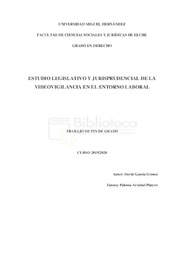Por favor, use este identificador para citar o enlazar este ítem:
https://hdl.handle.net/11000/25773Registro completo de metadatos
| Campo DC | Valor | Lengua/Idioma |
|---|---|---|
| dc.contributor.advisor | Arrabal Platero, Paloma | - |
| dc.contributor.author | García Gómez, David | - |
| dc.contributor.other | Departamentos de la UMH::Ciencia Jurídica | es_ES |
| dc.date.accessioned | 2022-01-27T09:06:19Z | - |
| dc.date.available | 2022-01-27T09:06:19Z | - |
| dc.date.created | 2020-09 | - |
| dc.identifier.uri | http://hdl.handle.net/11000/25773 | - |
| dc.description.abstract | El presente trabajo se basa en el análisis del avance y actual estado de la legislación y la jurisprudencia respecto a la videovigilancia empresarial. Dada la especial invasividad de este tipo de instrumentos de control, se han definido y relacionado, tanto los derechos afectados del trabajador como los que legitiman al empleador al uso de este tipo de vigilancia, siendo la prioridad de legisladores y tribunales encontrar un punto de equilibrio entre ambos. Asimismo, se han seleccionado cuatro sentencias de gran relevancia en el campo para realizar unos análisis con los que relacionar los conceptos expuestos anteriormente y poder extraer conclusiones sobre el estado del campo. Se han elegido esas cuatro sentencias al ser ejemplos representativos, con el objetivo de mostrar un reflejo fiel de la evolución jurisprudencial de la materia y, al mismo tiempo, tratar la compleja cuestión sobre la legitimidad o ilegitimidad de una prueba obtenida a través de la videovigilancia en el proceso | es_ES |
| dc.description.abstract | The present study is based on the analysis of the progress and current state of legislation and case law regarding corporate video surveillance. Given the special invasiveness of this type of control instruments, both the affected rights of the worker and those that legitimize the employer to use this type of surveillance have been defined and related, being the priority of legislators and courts to find a balance between both. Likewise, four judgments of great relevance in the field have been selected to carry out analyses with which to relate the concepts set out above and to be able to draw conclusions on the state of the field. These four sentences have been chosen as they are representative examples, with the aim of showing a faithful reflection of the jurisprudential evolution of the subject and, at the same time, dealing with the complex question of the legitimacy or illegitimacy of evidence obtained through video surveillance in the process | es_ES |
| dc.format | application/pdf | es_ES |
| dc.format.extent | 58 | es_ES |
| dc.language.iso | spa | es_ES |
| dc.publisher | Universidad Miguel Hernández de Elche | es_ES |
| dc.rights | info:eu-repo/semantics/openAccess | es_ES |
| dc.rights | Attribution-NonCommercial-NoDerivatives 4.0 Internacional | * |
| dc.rights.uri | http://creativecommons.org/licenses/by-nc-nd/4.0/ | * |
| dc.subject | vídeovigilancia | es_ES |
| dc.subject | protección de datos | es_ES |
| dc.subject | derecho procesal | es_ES |
| dc.subject | privacidad | es_ES |
| dc.subject | poder del empleador | es_ES |
| dc.subject.other | CDU::3 - Ciencias sociales::34 - Derecho | es_ES |
| dc.title | Estudio legislativo y jurisprudencial de la videovigilancia en el entorno laboral | es_ES |
| dc.type | info:eu-repo/semantics/bachelorThesis | es_ES |

Ver/Abrir:
TFG-García Gómez, David.pdf
1,71 MB
Adobe PDF
Compartir:
 La licencia se describe como: Atribución-NonComercial-NoDerivada 4.0 Internacional.
La licencia se describe como: Atribución-NonComercial-NoDerivada 4.0 Internacional.
.png)